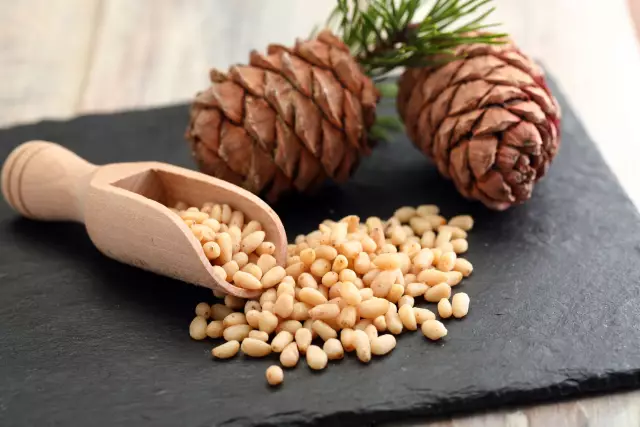- Author Rachel Wainwright [email protected].
- Public 2023-12-15 07:39.
- Last modified 2025-11-02 20:14.
Pine nuts
Pine nuts are a treasure trove of nutrients. The name is generic and is used to refer to several types of seeds from the pine genus, which are also called cedar pines, and produce edible seeds. In a scientific sense, they are not nuts, but this name is quite firmly entrenched for them in cooking.
The ratio of BJU in the product

Source: depositphotos.com How to burn 673 kcal?
| Walking | 168 minutes |
| Jogging | 75 minutes |
| Swimming | 56 minutes |
| A bike | 96 minutes |
| Aerobics | 135 minutes |
| Household chores | 224 minutes |
Composition of pine nuts
According to studies, only 43% of the total weight of the nut weighs the kernel itself. It is in the composition of pine nut kernels that the maximum amount of useful microelements, vitamins, proteins, fats and carbohydrates is contained. 63.9% of the kernel consists of high-quality oil, but 17.2% are easily digestible proteins, containing about 19 amino acids, 70% of which are conditionally irreplaceable.
The shell of pine nuts, which is more than half (55-60%) of the total mass of seeds, contains amino acids, tannins, trace elements and sugars. In terms of chemical composition, the shell is a real source of fats, proteins, resins, fiber, ash, micro and macro elements, pentosans.
Useful properties of pine nuts
The healing and nutritional properties of these nuts can be largely explained by a fairly high-quality composition, which includes a mass of proteins, fats and many other useful substances. Fat of pine nuts differs from numerous other fats in that it contains many polyunsaturated fatty acids, in particular linoleic acid.
Of the various nitrogenous substances in the nut, proteins with a high content of amino acids predominate, and arginine is the predominant one. This amino acid is especially important for a growing organism and its development, therefore, nuts should be an indispensable element in the diet of pregnant women, adolescents and children. In addition, the proteins of pine nuts are easily digestible.
Such nuts are valuable carriers of fat-breaking vitamins P and E. Vitamins of group E (their second name is tocopherols) are incredibly important for ensuring good and complete heredity - even in the Greek word "tocopherol", denoting the second name of this group of vitamins, the meaning "I bear offspring ". Provided that the body does not have enough of this vitamin, the fat balance may be disturbed. Vitamin E obtained from pine nuts is responsible for the formation of milk in nursing mothers, therefore, in the absence or even a lack of this vitamin, lactation may stop. The tendency to atherosclerosis is also largely due to a lack of vitamin E.
The benefits of pine nuts also lie in the content of a complex of B vitamins, which normalize the functioning of the nervous system, and also significantly improve the composition of the blood, and have a beneficial effect on the development of the body. It is nuts that are an irreplaceable remedy against B-avitaminosis.
Pine nut kernels are rich in a variety of valuable trace elements and minerals. The chemical composition of nuts confirms their nutritional value. So, for example, pine nuts significantly surpass all other nuts in terms of phosphatide phosphorus content, they are also a rich source of iodine.
It is pine nuts that contain such a variety of trace elements and amino acids, which is sufficient to meet the daily requirement for cobalt, zinc, manganese and copper. The digestibility of nuts is quite high, so their benefits for the body are incredibly high.
The benefits of pine nuts are also contained in its shell, which, when crushed, is widely used as an additive in animal feed. In comparison with the mass of other feeds, this one has an average nutritional value, but contains a lot of fiber, thus increasing the digestibility of the feed.
In the process of extracting pine nut oil from the kernel by the method of cold pressing, special cedar cake remains, it is rich in various microelements, biologically active substances, vitamins of group B, C, E and A, proteins, unsaturated fatty acids. In addition, the cake does not contain cholesterol. It is an excellent dietary product, the use of which normalizes metabolism, maintains efficiency and maintains health for many years.
Adding pine nuts, oil from it or cake to various desserts (be it pastries, cakes or ice cream), vegetable and fruit salads allows you to give the dish an incomparable delicate taste.
In addition to medicine, pine nut oil is also used in technical industries, for example, for the manufacture of the highest quality optics.
The use of pine nuts in traditional medicine
Always very widely and willingly, nuts have been used in folk medicine in the treatment of a wide variety of diseases. For example, for the Siberian population, nuts were and are the most effective treatment for salt deposits in the joints. Pine nut kernels were the basis of alcoholic tinctures, which were taken in a few drops for a month to treat many diseases.

The properties of pine nuts make it possible to use their cake and husk for the preparation of effective cleaning baths. Such a bathroom (in addition, bran is added to it) has the most beneficial effect on the skin and is recommended for eczema, diathesis, pustular and other skin diseases.
Tincture of pine nuts is widely used in the treatment of gout, rheumatism, vitamin deficiency, metabolic disorders. Since nut shells are an incredibly rich source of tannins, decoctions and tinctures are prepared from it, used to treat inflammation of the mucous membranes and skin diseases. The properties of pine nuts also make it possible to use them in the treatment of diseases of the gastrointestinal tract.
Tincture of pine nut kernels is taken as a blood purifier. But with a peptic ulcer, it is useful to use chopped kernels of nuts. In folk medicine, it is believed that with a wide variety of skin diseases, boils, eczema and even cancer, regular consumption of pine nuts can lead to recovery.
The benefits of pine nuts cannot be overestimated for both children and adolescents, in whose diet they must be mandatory, as they have a beneficial effect on mental and physical development.
Harm of pine nuts
It is not recommended for people with a tendency to allergies to consume nuts, as this can lead to an allergic attack. The consumption of low-quality pine nuts also contributes to serious disturbances in taste. True, such a violation can go away in a few days and without medical assistance.
YouTube video related to the article:
Found a mistake in the text? Select it and press Ctrl + Enter.






